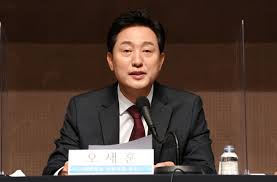In a move that could be described as either a bold leap forward or a desperate grasp at straws, Seoul’s Mayor Oh Se-hoon has announced a new housing scheme aimed at tackling South Korea’s demographic crisis. Seoul is in South Korea, right? But this isn’t a K-pop story. The crisis, fuelled by an alarmingly low birth rate, has prompted this innovative approach to incentivise newlyweds to settle down and, ideally, start families.
During a meeting at Seoul City Hall on 29 May, Mayor Oh unveiled his administration’s plan to provide 4,396 public housing units to newlyweds over the next three years. The initiative, part of the “Plan to Expand Housing for Newlyweds in Response to Low Birthrates,” seeks to make subsidised housing more accessible to young couples.
Way below ‘Replacement Rate’
Mayor Oh noted, with a hint of practicality, “Until now, it was easy to enter public housing only if you had a large number of children, but now you can enter public housing even if you don’t have children.” This pivot underscores the urgency of the situation, as South Korea grapples with a birth rate that plummeted from 0.78 in 2022 to a staggering 0.72 in 2023. To put that in perspective, population scientists consider 2.1 as the replacement rate necessary to maintain a stable population.
In a twist that may make some chuckle and others sigh, this scheme is open to newlyweds who don’t own their own homes, couples married for up to seven years, and even those planning to tie the knot within six months of the announcement. The plan includes benefits that vary based on the number of children, with extended residency periods and significant discounts on home purchases for larger families.
Mayor Oh is no stranger to such ambitious projects. His earlier initiative, the “Long-term Rental Housing” scheme, introduced in 2007 and colloquially known as “SHift,” was touted as a success, supposedly proving that stable housing supply can boost birth rates. The mayor insists that this new scheme will have a similar effect.
Look at India!
However, let’s cast our eyes halfway around to India, a country with its own set of housing and population challenges. India’s population boom is leading to overcrowded cities, housing shortages, and overpopulation issues that make Seoul’s problems look almost quaint by comparison. While South Korea’s officials scramble to encourage more births, India’s planners should be wrestling with how to house and sustain an ever-growing populace.
The irony is palpable. Seoul is trying to nudge its birth rate upwards, while India faces the daunting task of managing a burgeoning population. Yet, both nations highlight the universal challenge of housing in modern society.
Fully Equipped and below market rate!
Mayor Oh’s vision also includes the “Newlywed Safety Housing” project, promising 2,000 units by 2026, conveniently located near transport hubs and equipped with modern appliances, such as refrigerators, washing machines, induction ovens, and air conditioners. This is all part of his grand plan to create a society where “society raises children together.”
The new scheme benefits will vary based on the number of children, the mayor’s press statement read.
For couples with only one child, the maximum residency period will be extended from 10 to 20 years. The couples are eligible to purchase the home at a 10 percent discount against the market price if they have two children.
Couples who have three children are eligible to buy the apartment at a rate that is 20 percent below the market price.
So, while Seoul’s administration pours resources into these well-intentioned schemes, one can’t help but wonder if such measures will truly tip the scales. After all, it’s a bit like trying to fill an ocean with a teacup – admirable effort, but is it enough? Only time will tell if these initiatives will lead to the desired baby boom or if they’ll merely be a footnote in the city’s ongoing struggle against demographic decline.


